DC Water Heating Elements
Overview of DC Water Heating Elements
Heat water directly using a DC water heating element in conjunction with a wind turbine generator or solar panel (with or without a battery bank).
DC Water Heating Elements with Wind Turbine Generators
Wind turbine generators are used primarily for electricity generation. The power used can be stored in a battery bank or connected to the main supply using a suitable grid tie inverter.
In very strong winds, and/or when the batteries are fully charged a wind turbine may generate more current than the batteries can handle. Therefore, a dump load is often used to divert the extra energy to heat water so it is not wasted and so that the wind turbine does not spin so quickly that it is damaged.
Jeff explains the types of dump divert loads that are safe and suitable for wind turbine (and solar panel) applications.
Click here to watch this video on our YouTube channel.
Diversion Load Water Heating

Pictured here is a typical 12V water heating element which can be screwed into an immersion heater draincock hole.
When used as a diversion (dump) load, such an element is connected to the batteries via a charge regulator (charge controller). When the regulator detects that the batteries are fully charged, it diverts the generated electricity to the DC water heating element, which then dissipates heating the water.
See the diagram below to see how the different components connect together to the DC water heating element.

Direct Wind Turbine Water Heating
It is not usually possible to connect a 12 Volt water heating element directly to the output from a wind turbine as the voltages generated by a 12 Volt wind turbine are typically far in excess of their nominal 12 Volt rating – with values of over 50 Volts often recorded in heavy winds.
These high voltages would rapidly burn out the water heating element when you need it most. A 12 Volt DC water heating element should be used with just 12-15 Volts, a 24V DC water heating element with just 24-30 Volts.
In order to prevent the water heating element from receiving fluctuating over-voltages, a small battery should be used as a buffer between the wind turbine output and the heating element.
A 12V motorcycle battery is perfect for this task (for 12 Volt immersion elements) – no more powerful than 4 amp hours / 50 cold cranking amps, and should be a lead-acid battery which can be refilled with water. A sealed gel type battery or dry cell should not be used.
The DC water heating element chosen must be closely matched to the typical power output of the wind turbine. If the element is too large (too high wattage rating), the wind turbine will not be able to start spinning unless the wind is very strong. If the water heating element wattage is too low, nothing will be damaged since the small battery will limit the voltage to around 12 volts, but heat will be dissipated in the wind turbine generator and cables rather than used to heat water.
If the DC water heating element is poorly matched, then there is the risk of a large voltage drop between the wind turbine generator and the element causing the cable between them to melt. In this case, the wind turbine would then freewheel at very high RPM and could easily be damaged to destroyed.
DC Water Heating Elements with Solar Panels

Jeff demonstrates how to connect the solar panel directly to the DC water heating element:
Click here to watch this video on our YouTube channel.
One popular application for our submersible DC water heating elements is preventing freezing in stock tanks used for livestock. You can add an optional freeze thermostat in line to keep the stock tank water from freezing.
Thanks for reading. You can find our DC water heating element listings here.
Recent Posts
-
Wind Turbine for Cabin | Alternative Energy for Remote Homes
Remote homes, whether cabins, hunting lodges, or vacation homes are excellent places to implement al …Dec 8th 2022 -
Lithium Ion Battery Pros & Cons | A User’s Guide
Lithium batteries are often seen as the vanguard of the alternative energy revolution. They offer …Nov 7th 2022 -
Battery Bank Configuration | The Wind & Solar Handbook
Your battery bank is, in many ways, the beating heart of your wind and solar system. Your panels and …Oct 19th 2022



